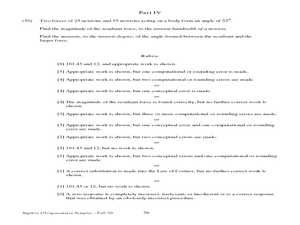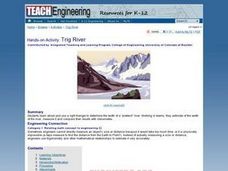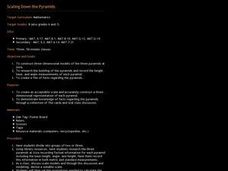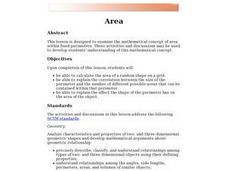NASA
Photons in the Radiative Zone: Which Way Is Out? An A-Maz-ing Model
Can you move like a photon? Young scholars use a maze to reproduce the straight line motion of a photon. The second in a six-part series of lessons on the sun has learners measure angle of incidence and refraction to determine the path...
Curated OER
Estimation Task
Upper graders practice their estimation skills by observing different objects then making their best guess without using measuring instruments. Learners are asked to estimate mass, length, volume, and area.
Curated OER
Solving Problems Using Triangle Inequality Theorem
Sixth graders investigate triangles and the inequality theorem. They will collaborate in groups to determine the length of a longest side of a triangle. Then relate the size of the triangle to its angles using protractors, yard sticks,...
Curated OER
Triangles Inscribed in a Circle
Are you tired of answers without understanding? Learners can give a correct response, but do they really understand the concept? Have young mathematicians think deeper about linear functions, angles, and formulas in algebra....
Curated OER
Trigonometric Ratios
Young scholars measure and analyze angles. In this trigonometry instructional activity, students measure angles and distances use non-traditional techniques. They identify the different ratios of sine, cosine and tangent.
Curated OER
Special Right Triangles
For this special right triangle worksheet, students use the trigonometric functions to determine angle measurement or the length of one side of a right triangle. This one-page worksheet contains 18 problems. Answers are provided at the...
Curated OER
Scoring Guide for the Algebra 2/Trigonometry Test Sampler
High schoolers take an Algebra II/Trigonometry sample test. In this Algebra II/Trigonometry sample sample test activity, students take a sample test for Algebra 2/Trigonometry. High schoolers solve 39 multiple...
Curated OER
Geometry: Classifying Angles
Students measure, construct, and classify angles as acute, right, straight, and obtuse. Once they have completed an angle worksheet, students use a map of South Carolina to locate cities by constructing the aforementioned angles.
Curated OER
Back to the Bees (Tesselations)
Sixth graders observe the creation of a tessellation with hexagons. In groups, they work with polygons to discover what shapes can be used to create tessellations and explore the angle measurements of each shape. Using internet websites,...
Curated OER
Up For Change?
Students explore similar objects. They participate in a series of hands-on, multimedia and online activities to examine how the edge length affects the angle measures, perimeters and areas of similar regular polygons. Students find the...
Curated OER
Trig River
Students calcute distances using trigonometry and angle measurements. They estimate the width of the Trig River, measure it and compare their results with their classmates. They collaborate with a group to research and find the results.
Curated OER
Electric Hoist Problem
Students convert angle measures between degrees and radians. They are given a copy of the task sheet with a graphic to help describe the situation. Pupils review the angle and arc relationship in a circle related to length of the...
Curated OER
Triangle Inequality Theorem
High schoolers investigate the relationship between angle measures and sides of a triangle and the relationships among the three sides of a triangle. The use of technology (Cabri, Jr.) allows learners to make and test conjectures as they...
Curated OER
Scaling Down the Pyramids
Students construct three-dimensional models of the three pyramids at Giza. They research the building of the pyramids and record the height, base and angle measurements of each pyramid. They create a file of facts regarding the pyramids.
Curated OER
How To Use A Protractor
Fifth graders use the SMART Board to demonstrate how to use a protractor to measure acute, obtuse, and right angles. In this protractor lesson plan, 5th graders also complete an angles worksheet.
Curated OER
Clockwise
Second graders investigate angles through this series of lessons. They determine how angles turn in both clockwise and anticlockwise directions. They examine the characteristics of quarter half turns and how they can begin from any...
Curated OER
Lesson Exchange: Polygons (Middle, Mathematics)
Pupils discover the relationship between the sides of a polygon and the number of diagonals that can be drawn from one vertex, the number of triangles that those diagonals form, and the sum of the interior angles of that polygon.
Curated OER
Geometry for the Technologies
Students discover how to use various tools to measure and draw angles. With protractors, they classify angles according to angle measure, identify vertical angles, and perform angle additions. For their final project, students create...
Curated OER
Classifying and Constructing Corners
Fifth graders, after seeing Honeycomb examples, complete a Classifying Angles worksheet, Clock worksheet, and Defining Angles worksheet.
Curated OER
Measurement Investigations 2
Students complete a number of practical measuring investigations, with an emphasis on accuracy of measuring and communication of their findings. They examine how to measure by first becoming aware of the physical attributes of objects...
Curated OER
Measurement Investigations 1
Fifth graders find perimeters, areas, and volumes of everyday objects and state the precision. They work in small groups in order to take measurements, perform calculations, and write a group report about the investigation.
Curated OER
Area Applet
Elementary math classes calculate the area of a shape and explain the correlation between the size of the perimeter and the areas that can be contained within that perimeter. They also explain the effect the shape of the perimeter has on...
EngageNY
The Angle-Angle (AA) Criterion for Two Triangles to Be Similar
What do you need to prove triangles are similar? Learners answer this question through a construction exploration. Once they establish the criteria, they use the congruence and proportionality properties of similar objects to find...
EngageNY
Using Trigonometry to Find Side Lengths of an Acute Triangle
Not all triangles are right! Pupils learn to tackle non-right triangles using the Law of Sines and Law of Cosines. After using the two laws, they then apply them to word problems.
Other popular searches
- Naming and Measuring Angles
- Estimate Angle Measurement
- Angle Measurement 8 Grade
- Right Angle Measurement
- Angle Measurement 4 Grade
- Vertical Angle Measurement
- Included Angle Measurement
- Degree, Angle Measurement
- Missing Angle Measures
- Measuring Angles Protractors
- Measuring Angles in Polygons
- Measuring Angles Clock Face























